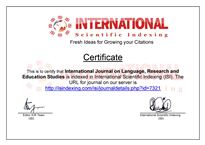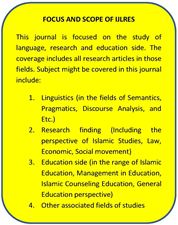An Analysis of Translation Techniques in the English Version of Arrahman Surah
Abstract
The Holy Qur’an has been translated into many languages including English. However, different translator of the Holy Qur’an produces different English version of Al-Qur’an because every translator uses different translation techniques to translate Al-Qur’an. This study aims to compare the three English versions of Arrahman surah, and describe the most dominant translation techniques used by the three translators to translate the Holy Qur’an. Translation techniques proposed by Molina and Albir (2002, p.509-511) are used to analyze the data. The data for this study are words, phrases, and clauses in the 78 verses of Arrahman surah in Arabic and its three English versions translated by Maulawi Sher ‘Ali, Dr. Muhammad TaqiudDin AlHilali and Dr. Muhammad Muhsin Khan, and Talal Itani. The result shows that there are four most dominant techniques used by the three translators in translating the Holy Qur’an; Adaptation, Amplification, Established Equivalent, and Literal Translation technique. The first and the second translator prefer to use Amplification to introduce details in brackets or footnotes, but the third translator prefers to use Established Equivalent to find a term or expression recognized (by dictionaries or language in use) as an equivalent.
Keyword: Qur’an, Surah Arrahman, Technique, Translation
Full Text:
PDFReferences
Ali, M.S. (2004). The Holy Qur’an: Arabic Text and English Translation. UK: Islam International Publications Limited.
.
Al-Hilali, M.T. & Khan, M.M. Translation of the meanings of The Noble Qur’an in the English Language. Madinah: King Fahd Complex For the Printing of the Holy Qur’an.
Hatim, B. and Munday, J.. (2004). Translation: An advanced resource book. New York: Routledge.
Holmes, J.S. (1988b/2004). The name and nature of translation studies in Lawrence Venuti (ed.) (2004), The translation studies reader, 2nd Edition.
Itani.T. Quran English Translation Clear, Pure, Easy to Read Modern English. Beirut: ClearQuran.
Khan, Mohd Imran. (2016). Stylistic Dimensions in Translations of the Holy Quran into English with Special Reference of Surah Al-Fatiha. British Journal of Education, Society & Behavioural Science, 12(4), 1-9.
Molina, L., & Albir, A. H. (2002). Translation Techniques Revisited: A Dynamic and Functionalist Approach. Meta, XLVII(4), 498-512.
Munday, J. (2012). Introducing Translation Studies (3 ed.). USA Canada: Routledge.
Newmark, P. (1988). A Textbook of Translation. Great Britain: Prentice Hall.
Venuti, L. (1995). The Translator's Invisibility. A History of Translation. London: Routledge.
www.routledgetranslationstudiesportal.com
Refbacks
- There are currently no refbacks.
Copyright (c) 2018 INTERNATIONAL JOURNAL ON LANGUAGE, RESEARCH AND EDUCATION STUDIES

This work is licensed under a Creative Commons Attribution-NonCommercial-ShareAlike 4.0 International License.

IJLRES- International Journal on Language, Research and Education Studies published by English Language Center, Faculty of Islamic Education and Teacher Training, UIN of North Sumatra is licensed under a Creative Commons Attribution-NonCommercial-ShareAlike 4.0 International License. Based on work at: http://jurnal.uinsu.ac.id/index.php/ijlres
2580-6777 (Print ISSN), 2580-6785 (Online ISSN)




